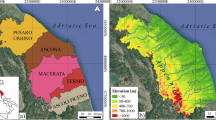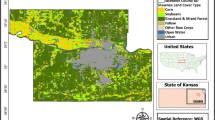Abstract
Real time, accurate and reliable estimation of maize yield is valuable to policy makers in decision making. The current study was planned for yield estimation of spring maize using remote sensing and crop modeling. In crop modeling, the CERES-Maize model was calibrated and evaluated with the field experiment data and after calibration and evaluation, this model was used to forecast maize yield. A Field survey of 64 farm was also conducted in Faisalabad to collect data on initial field conditions and crop management data. These data were used to forecast maize yield using crop model at farmers’ field. While in remote sensing, peak season Landsat 8 images were classified for landcover classification using machine learning algorithm. After classification, time series normalized difference vegetation index (NDVI) and land surface temperature (LST) of the surveyed 64 farms were calculated. Principle component analysis were run to correlate the indicators with maize yield. The selected LSTs and NDVIs were used to develop yield forecasting equations using least absolute shrinkage and selection operator (LASSO) regression. Calibrated and evaluated results of CERES-Maize showed the mean absolute % error (MAPE) of 0.35–6.71% for all recorded variables. In remote sensing all machine learning algorithms showed the accuracy greater the 90%, however support vector machine (SVM-radial basis) showed the higher accuracy of 97%, that was used for classification of maize area. The accuracy of area estimated through SVM-radial basis was 91%, when validated with crop reporting service. Yield forecasting results of crop model were precise with RMSE of 255 kg ha−1, while remote sensing showed the RMSE of 397 kg ha−1. Overall strength of relationship between estimated and actual grain yields were good with R2 of 0.94 in both techniques. For regional yield forecasting remote sensing could be used due greater advantages of less input dataset and if focus is to assess specific stress, and interaction of plant genetics to soil and environmental conditions than crop model is very useful tool.








Similar content being viewed by others
References
Ahmad, A., Ashfaq, M., Rasul, G., Wajid, S. A., Khaliq, T., & Rasul, F., et al. (2015). Impact of climate change on the rice–wheat cropping system of Pakistan. In C. Rosenzweig, & D. Hillel (Eds.), Handbook of climate change and agroecosystems: The agricultural model intercomparison and improvement project (AgMIP). ICP Series on climate change impacts, adaptation, and mitigation, (Vol 3(Part 2), pp. 219–258).
Algur, S. P., Goudannavar, B. A., & Bhat, P. (2002). Classification and analysis of web multimedia data using. La Crau: Principal Component Analysis.
Allen, R. G., Pereira, L. S., Raes, D., & Smith, M. (1998). Crop evapotranspiration-Guidelines for computing crop water requirements-FAO Irrigation and drainage paper 56. FAO, Rome, 300(9), D05109.
Anbazhagan, S., & Paramasivam, C. R. (2016). Statistical correlation between land surface temperature (LST) and Vegetation Index (NDVI) using multi-temporal landsat TM data. International Journal of Advanced Earth Science and Engineering, 5(1), 333.
Batchelor, W. D., Basso, B., & Paz, J. O. (2002). Examples of strategies to analyze spatial and temporal yield variability using crop models. European Journal of Agronomy, 18(1–2), 141–158.
Boote, K. J., Jones, J. W., & Pickering, N. B. (1996). Potential uses and limitations of crop models. Agronomy Journal, 88(5), 704–716.
Briscoe, J., & Qamar, U. (2006). Pakistan’s water economy: Running dry. Oxford: University Press Karachi.
Chisanga, C. B., Phiri, E., Shepande, C., & Sichingabula, H. (2015). Evaluating CERES-Maize model using planting dates and nitrogen fertilizer in Zambia. Journal of Agricultural Science, 7(3), 79.
Dorosh, P., & Salam, A. (2008). Wheat markets and price stabilisation in Pakistan: An analysis of policy options. The Pakistan Development Review, 47, 71–87.
Dumont, B., Basso, B., Leemans, V., Bodson, B., Destain, J.-P., & Destain, M.-F. (2015). A comparison of within-season yield prediction algorithms based on crop model behaviour analysis. Agricultural and Forest Meteorology, 204, 10–21.
Erda, L., Wei, X., Hui, J., Yinlong, X., Yue, L., Liping, B., et al. (2005). Climate change impacts on crop yield and quality with CO2 fertilization in China. Philosophical Transactions of the Royal Society B: Biological Sciences, 360(1463), 2149–2154.
Fontana, D. C., Weber, E., Ducati, J., Figueiredo, D. C., Berlato, M. A., & Bergamaschi, H. (2000). Monitoramento e previsão de safras no Brasil. In Simposio lationamericano de percepcion remota sistemas de informacion espacial (Selper) (Vol. 9, pp. 87–96). SELPER Puerto Iguazú.
Fraisse, C. W., Sudduth, K. A., & Kitchen, N. R. (2001). Calibration of the CERES–MAIZE model for simulating site–specific crop development and yield on claypan soils. Applied Engineering in Agriculture, 17(4), 547.
Friedl, M. A., McIver, D. K., Hodges, J. C. F., Zhang, X. Y., Muchoney, D., Strahler, A. H., et al. (2002). Global land cover mapping from MODIS: Algorithms and early results. Remote Sensing of Environment, 83(1), 287–302.
Gaiser, T., Barros, I. De, Sereke, F., & Lange, F. (2010). Agriculture, Ecosystems and Environment Validation and reliability of the EPIC model to simulate maize production in small-holder farming systems in tropical sub-humid West Africa and semi-arid Brazil. Agriculture, Ecosystems and Environment, 135, 318–327. https://doi.org/10.1016/j.agee.2009.10.014.
Genovese, G. P., Fritz, S., & Bettio, M. (2006). A comparison and evaluation of performances among crop yield forecasting models based on remote sensing: Results from the geoland observatory of food monitoring. International Archives of the Photogrammetry, Remote Sensing and Spatial Information Sciences, 36, 71–77.
Jagtap, S. S., & Jones, J. W. (2002). Adaptation and evaluation of the CROPGRO-soybean model to predict regional yield and production. Agriculture, Ecosystems and Environment, 93(1), 73–85.
Johnson, D. M. (2014). An assessment of pre-and within-season remotely sensed variables for forecasting corn and soybean yields in the United States. Remote Sensing of Environment, 141, 116–128.
Johnson, B., Tateishi, R., & Xie, Z. (2012). Using geographically weighted variables for image classification. Remote Sensing Letters, 3(6), 491–499.
Jones, C. A., Kiniry, J. R., & Dyke, P. T. (1986). CERES-Maize: A simulation model of maize growth and development. College Station: Texas A&M University Press.
Lee, B.-H., Kenkel, P., & Brorsen, B. W. (2013). Pre-harvest forecasting of county wheat yield and wheat quality using weather information. Agricultural and Forest Meteorology, 168, 26–35.
Lin, Y., Wu, W., & Ge, Q. (2015). CERES-Maize model-based simulation of climate change impacts on maize yields and potential adaptive measures in Heilongjiang Province, China. Journal of the Science of Food and Agriculture, 95(14), 2838–2849. https://doi.org/10.1002/jsfa.7024.
Liu, H., Yang, J., Ping, H., Bai, Y., Jin, J., Drury, C. F., et al. (2012). Optimizing parameters of CSM-CERES-Maize model to improve simulation performance of maize growth and nitrogen uptake in northeast China. Journal of Integrative Agriculture, 11(11), 1898–1913.
Mkhabela, M. S., & Mkhabela, M. S. (2000). Exploring the possibilities of using noaa, vhrr data to forecast cotton yield in swaziland. UNISWA Journal of Agriculture, 9(1), 13–21.
Moen, T. N., Kaiser, H. M., & Riha, S. J. (1994). Regional yield estimation using a crop simulation model: Concepts, methods, and validation. Agricultural Systems, 46(1), 79–92.
Mubeen, M., Ahmad, A., Wajid, A., Khaliq, T., Hammad, H. M., Sultana, S. R., et al. (2016). Application of CSM-CERES-Maize model in optimizing irrigated conditions. Outlook on Agriculture, 45(3), 173–184.
Orhan, O., Ekercin, S., & Dadaser-Celik, F. (2014). Use of landsat land surface temperature and vegetation indices for monitoring drought in the Salt Lake Basin Area, Turkey. The Scientific World Journal. https://doi.org/10.1155/2014/142939.
Osborne, J. W., & Waters, E. (2002). Multiple regression assumptions. Washington, DC: ERIC Digest.
Panda, S. S., Ames, D. P., & Panigrahi, S. (2010). Application of vegetation indices for agricultural crop yield prediction using neural network techniques. Remote Sensing, 2(3), 673–696.
Ramachandra, T. V., Kumar, U., & Dasgupta, A. (2016). Time-series MODIS NDVI based vegetation change analysis with land surface temperature and rainfall in Western Ghats, India (Vol. 100, pp. 50–100). ENVIS Technical Report.
Saseendran, S. A., Ma, L., Nielsen, D. C., Vigil, M. F., & Ahuja, L. R. (2005). Simulating planting date effects on corn production using RZWQM and CERES-Maize models. Agronomy Journal, 97(1), 58–71.
Schafer, A., & Victor, D. G. (2000). The future mobility of the world population. Transportation Research Part A: Policy and Practice, 34(3), 171–205.
Singh, R. P., Roy, S., & Kogan, F. (2003). Vegetation and temperature condition indices from NOAA AVHRR data for drought monitoring over India. International Journal of Remote Sensing, 24(22), 4393–4402.
Van Wart, J., Kersebaum, K. C., Peng, S., Milner, M., & Cassman, K. G. (2013). Estimating crop yield potential at regional to national scales. Field Crops Research, 143, 34–43.
Xiong, W., Matthews, R., Holman, I., Lin, E., & Xu, Y. (2007). Modelling China’s potential maize production at regional scale under climate change. Climatic Change, 85(3), 433–451.
Yun, J. I. (2003). Predicting regional rice production in South Korea using spatial data and crop-growth modeling. Agricultural Systems, 77(1), 23–38.
Zhang, F., Wu, B. F., Liu, C. L., Luo, Z. M., Zhang, S. W., & Zhang, G. L. (2004). A method for extract regional crop growth profile with time series of NDVI Data. Journal of Remote Sensing, 8(6), 515–528.
Author information
Authors and Affiliations
Corresponding author
About this article
Cite this article
Ahmad, I., Saeed, U., Fahad, M. et al. Yield Forecasting of Spring Maize Using Remote Sensing and Crop Modeling in Faisalabad-Punjab Pakistan. J Indian Soc Remote Sens 46, 1701–1711 (2018). https://doi.org/10.1007/s12524-018-0825-8
Received:
Accepted:
Published:
Issue Date:
DOI: https://doi.org/10.1007/s12524-018-0825-8




